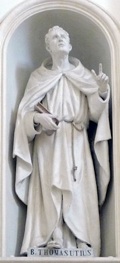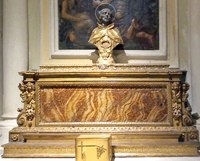


Statue of the Blessed Tomasuccio in the Duomo, Foligno
Tomasuccio was born in 1319 at Valmacinaia , near Nocera Umbra.
Gualdo Tadino
As a young man, Tomasuccio lived for 20 years as a follower of Pietro da Gualdo a near Rigali, to the south of Gualdo Tadino. It seems that both men were “fraticelli”, followers of St Francis who sought to live according to the “pure” form of the life that he had advocated. When Pietro da Gualdo died in ca. 1367, Tomasuccio to moved one of the five hermitages in the Valle di San Marzio that were to be subsumed in 1521 by the the Convento di Santa Maria Annunziata.
After three years there, he attracted the attention of the Inquisition when a colleague denounced him for refusing to make confession (presumably because he did not approve of the priest appointed for the purpose). Mario Sensi (referenced below) associates this with the moves against the fraticelli taken by Pope Urban V in 1365. Blessed Tomasuccio was acquitted of the charges against him, but nevertheless decided to leave Umbria for Tuscany.
Siena, Spain and Perugia
It was in Arezzo, en route to Siena, that Tomasuccio met his follower and future biographer Giusto della Rosa (below). He was imprisoned once more in Siena.
After his release, he made a pilgrimage to Santiago da Compostella, and during his time in Spain he became associated with the nascent eremitical movement that became known as the Hieronymites (Hermits of St Jerome): while the hermits of Italy based their way of life on that of St Francis, those of Spain looked to the example of St Jerome in the desert.
On his return to Italy, the Blessed Tomasuccio travelled Via Florence (where he spent another short period in prison) to Perugia. It was during this stay that, at the request of Bartolomeo di Ser Riccardo Lardi, he apparently wrote his famous prophecies. An angel then appeared to him and ordered him to Foligno, where he should spend the rest of his life. In answer to his question, the angel told him that he would die there after four years.
While en route to Foligno, the Blessed Tomasuccio stopped in an abandoned church on the Feast of All saints and had a vision of paradise that lasted all day. St Francis appeared to him and ordered him to remind his brothers that he had shown them the way to salvation through “la santa regola e poverta” (a reference to the need to follow the spirit of the original Franciscan way of life).
Foligno
At Foligno, the Blessed Tomasuccio became attached to the Ospedale della SS Trinità. He probably joined the quasi-Franciscan group known as the Clareni. In 1377, he prophesied the imminent violent death of Trincia Trinci: shortly thereafter Trinci was murdered by Ghibelline exiles led by Corradino and Napoleone Brancaleone. Mario Sensi (referenced below) suggests that misreading of documents relating to this prophecy led to the common misconception that Tomasuccio himself also died in 1377, shortly after the murder of Trincia Trinci. In fact, the year of his death is unknown.
Prophecies of the Blessed Tomasuccio
The prophecies attributed to the Blessed Tomasuccio take the form of a poetic lament in 212 verses, which starts with a denunciation of the popes involved in schism of 1378: Urban VI and Clement VII. They also lament (among other examples of civic strife in Italy) the murder of Queen Joanna I of Naples in 1382. They end with the so-called Prophecy of the Worthy Shepherd, which predicts a pope (the worthy shepherd) who will “emerge from the shadows” twelve years after the millenium and “restore the Church to its beauty”.
These prophecies were clearly written after the murder of Joanna I in 1382 but before the end of the papal schism in 1409. Scholars who have accepted the traditional date of the death of the Blessed Tomasuccio (i.e. 1377) obviously cannot accept his authorship. However, Mario Sensi (referenced below) points out that this date is suspect and does not throw light on this complicated matter.
Relics and Cult

As noted above, the Blessed Tomasuccio died (according to tradition, on 15th September) in an unknown year around 1400 at the Ospedale della SS Trinità. He was almost certainly buried there. On 19th November of an unknown year, probably before 1444, his relics were translated to a chapel in Sant’ Agostino that was dedicated to him. Their history in the church can be summarised as follows:
-
✴A chapel dedicated to the Blessed Tomasuccio, which presumably housed the relics, was documented in a will of 1444.
-
✴Work on the reconstruction of this chapel in the left transept was nearing completion in 1452.
-
✴When Pope Sixtus IV venerated the relics during a visit to Foligno in 1475, they were on the high altar, presumably because the chapel mentioned above was in restoration.
-
✴This restoration was completed in 1477, and the relics were presumably moved back there soon after. They were certainly there in 1512, when the chapel was fitted with a grill, following an attempted robbery.
-
✴They were translated to the Cappella del Crocifisso in the early 17th century.
Antonio Poggi rebuilt the original chapel in 1661, and the relics were subsequently returned here: his arms appear in the chapel and on the gilded wooden reliquary in which the relics are now preserved.
There is evidence that the “bread of the Blessed Tomasuccio” was distributed on his feast day in Nocera Umbra, Foligno and (for an unknown reason) in Spello over a prolonged period, with the endorsement of the respective civic authorities. This tradition, which was enacted on the 19th November (the anniversary of the translation of the relics to Sant’ Agostino) celebrated the care that the Blessed Tomasuccio had given to the poor.
The people of Nocera Umbra, the birth place of the Blessed Tomasuccio, seem to have been content to regard this chapel in Foligno as the centre of his cult. On November 18th 1744, during the War of Austrian Succession, Nocera came under a heavy artillery attack from a Spanish army. The Austrian forces billeted in the city were prevailed upon to surrender, and the city escaped relatively unscathed. The citizens attributed their salvation to the Blessed Tomasuccio, on whose feast day the attack had ended. They placed one of the Spanish cannonballs on the altar in his chapel in Sant’ Agostino. [Is it still there ?] The Commune of Nocera wanted to rebuild the chapel at this point, but the Poggi family declined the offer.
In ca. 1890, Monsignor Michele Faloci Pulignani, the leading prelate in Foligno, undertook what proved to be the difficult and delicate task of reviving the cult of the Blessed Tomasuccio, with a view to securing papal recognition. His publications referenced below formed part of this initiative. However, his efforts came to nothing.
Read more:
M. Sensi, “Il Beato Tomasuccio: Biografi, Biografie e Culto”, in
“Le Osservanze Francescane nell' Italia Centrale (Secoli XIV-XV)”, (1985) Rome (pp 97-135)
R. Pazzelli (Ed), “Beato Tomasuccio da Foligno, Terziario Francescano ed i Movimenti Religiosi Popolari Umbri nel Trecento”, (1979) Rome
L. Jacobilli, “Vite de’ Santi e Beati di Foligno”, (1628) Foligno (pp 365-72)
M. Faloci Pulignani published editions of the prophecies of the Blessed Tomasuccio, his vision of paradise:
“Profezie del Beato Tomasuccio”, Miscellanea Francescana 1 (1886) 81-88, 121-125, 151-157, 173-182
“La Visione del Beato Tomasuccio”, Miscellanea Francescana 8 (1901) 148-158
“La Leggenda del Beato Tomasuccio”, Miscellanea Francescana
31 (1931) 244-51;
32 (1932) 6-17 and 53-67
Return to Saints of: Foligno Gualdo Tadino Nocera Umbra

